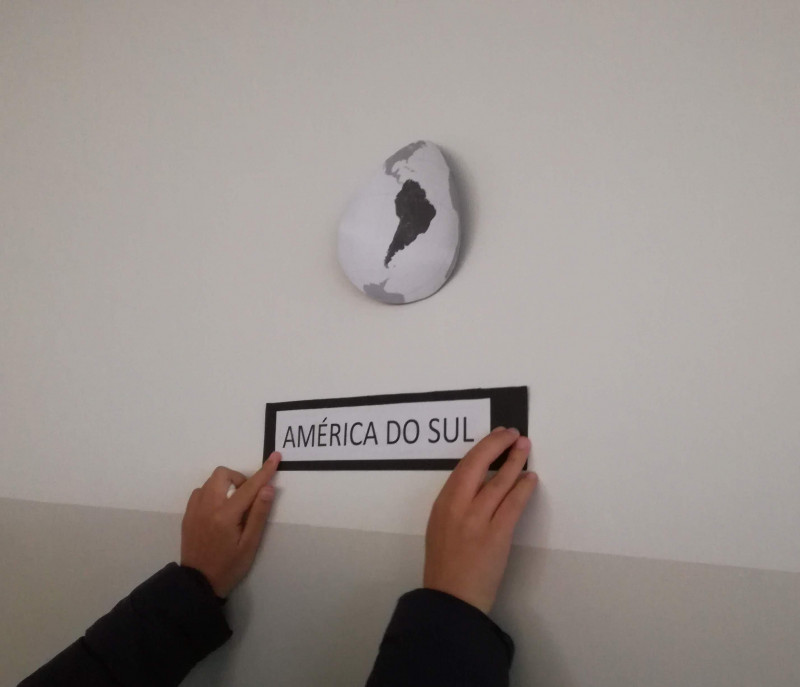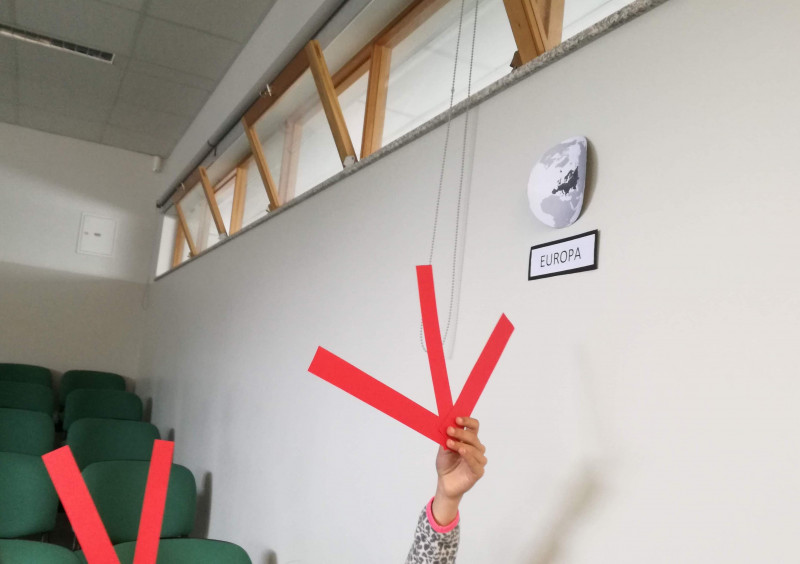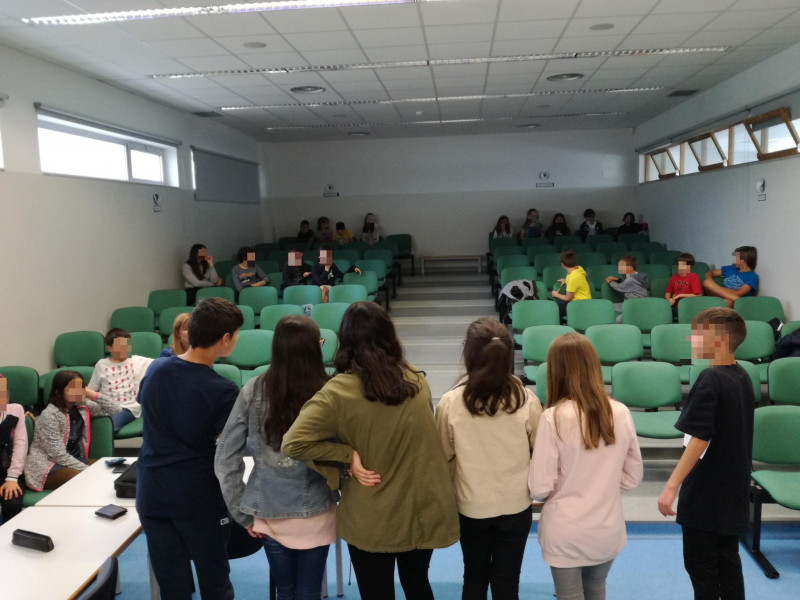How to contribute to a social just world? The experience in Portugal
3. Children take action
3.2. Food available in each continent: is it fair? (age range: 10+)
First, papers with continents’ name are distributed throughout the classroom.

2-3 children can be volunteers and divide the whole group of children between continents according to the population of each continent.
Then, other children can be asked if they agree with that disposition.
Different dispositions of children, depending on the children’s suggestions, can be tried.
The teacher can then reveal to children the real distribution of the world's population.
If there are 20 children*:
- Asia – 11 children representing the population
- Europe – 2 children representing the population
- Africa – 3 children representing the population
- North America – 1 child representing the population
- South America – 2 children representing the population
- Oceania – 1 child representing the population
Then 2-3 other volunteers can distribute 30 papers (representing food) between continents, meaning how much food each continent has to live with. Other children can be asked if they agree with that disposition, according to what they know about inequalities worldwide.

Then, the teacher can then dispose papers to reflect the real distribution of the continents’ access to food.
If there are 20 children*:
- Asia – 4 pieces of paper representing the food
- Europe – 9 pieces of paper representing the food
- Africa – 1 piece of paper representing the food
- North America – 10 pieces of paper representing the food
- South America – 1 piece of paper representing the food
- Oceania – 5 pieces of paper representing the food
*Retrieved from Concern Worldwide (2013)
Teachers can further explain that in Asia, for example, China has approximately 3 of the papers (meaning 3 /4 of the whole continent access to food).
Teachers can also highlight that even within countries there are inequalities and that inequalities are getting worse in this rapidly changing world.
A discussion and reflection with children can be held.
Prompts for discussion:
- How did children from different continents feel?
- How fair/unfair was the food distribution?
- What would make the distribution fair?
- Who is responsible to ensure that every human being has equal access to food?
The activity can be recorded in pictures or video that can be shared in the ISOTIS platform with peers, teachers and parents.
Older students (12-15 years old) presented the activity to a group of younger students (10-12 years old) in two separate moments, with two different groups.

First, students had to divide themselves into five groups, each group representing a continent. Right from the start children started actively discussing how they would distribute themselves. For example, in one of the groups, one student kept arguing that “Asia has more population than America”, but others didn’t agree. After an initial distribution, every time a student made a proposal to add or remove students from one continent to the other, other students would vote if they agreed with their hand raised. When the students achieved a minimum consensus on the world distribution of population per continents, the group implementing the activity revealed the real values. The distribution wasn’t correct in any continent, in both groups. While students located fewer students in Asia than it was meant to have, students thought that other continents were more populated than they were. Students expressed their astonishment when hearing the real values. In the end, children shared some thoughts about the world distribution of the population. For example, in one of the groups, one student referred “I thought that Asia had fewer people”. Then, one student added, “once I borrowed a book that said that Asia was the continent with more population”. Then, children were invited to think about which Asian countries were the two more populated countries in the world. The first that children named was China and, after a few incorrect attempts, they were able to identify the second, India. In the second group, one of the students observed “[the population of] Asia represents more than half the world population”. A student spontaneously mentioned, “Asia has China that has more than a billion of inhabitants, it has Russia that is very big, it has India that is big”. Another completed by mentioning “Bangladesh has more habitants than Russia”. The teacher confirmed online.
After the discussion on the distribution of population, children were invited by their older peers to distribute thirty pieces of paper between the five continents. Once again, students actively discussed with each other how they thought the distribution of food would be. Nevertheless, in the end, their distribution was very far from reality. Overall, students thought that Europe, Oceania and North America had less food available than they actually do and that Asia, Africa, and South America had more food than they have. In a nutshell, they thought that the world was more just, meaning that available food was distributed more evenly. When their older peers revealed the real distribution, younger students expressed their outrage particularly concerning the amount of food available in North America. Some reactions were “How much? Gee!”, “it doesn’t make sense that North America has 13 [pieces of paper, representing the quantity of food available], one person with 13!”, “it’s not fair” and “it’s a problem that North America has a lot of food and other have little”. In one of the groups, students claimed “it’s because it is very rich”, “I am not surprised”, and “it doesn’t impress me that much, there is a lot of obesity there, a lot of food is wasted there, it even makes sense”. Regarding the food available in Asia, students mentioned “we were surprised” and “as Asia had a lot of population everyone thought they had a lot of food, but it is very poor”. Additionally, they also referred “I was surprised by the distribution in South America” and “in Europe, there is a lot of food”.
When the teacher asked if this distribution was problematic, children were clear: “it is a problem”, “this is an important issue” and “everyone should have the same food, but some continents need more than others”, “every day someone can be dying with hunger and we are here wasting food”. When asked about what we could do to mitigate these inequalities, in the first group, a student mentioned: “to not waste food”. The teacher provoked “but if you don’t waste food how does that helps others having food?”. The child was silent thinking and answered, “giving food”. Another student completed “giving donations”. The teacher then asked if donating food or money would help the continents in need. The child answered, “it depends, if the leaders want that the money goes really for charity, then it also helps slowly”. Another completed “a lot of people don’t care”. Visibly displeased one of the children expressed “people receive miserably and lose the food they cultivate with exportations and live in poverty”. The teacher provoked “what if they keep the food?”, to which the child answered, “they are required to, they do slave work, they don’t see their family, they are mandated to send [food] to other countries, for it to be wasted”. In the other group, solutions to inequalities presented by children were also centered in donations: “to donate”, “if North America gave a little and donated for example to Africa”. To this solution a child countered with “if we simply donate the money, it finishes in little time, we need to help develop the countries”. When the teacher asked how, the child answered, “teaching techniques”. On the other hand, a child proposed “some countries shouldn’t sell their food”, to which another child reacted “but they don’t have money” and another “they earned very little with food production but they have to sell theirs to buy, not only to eat but to have a house, buy clothes”. The teacher concluded the activity in both groups by stating that these are “complex problems”, “hard to solve”, in which “one solution can cause more problems”.
Links with the curriculum:
- Geography – countries and continents, population
- Mathematics – awareness of numbers and percentages of the population
- Citizenship education – human rights, interculturality, social justice.